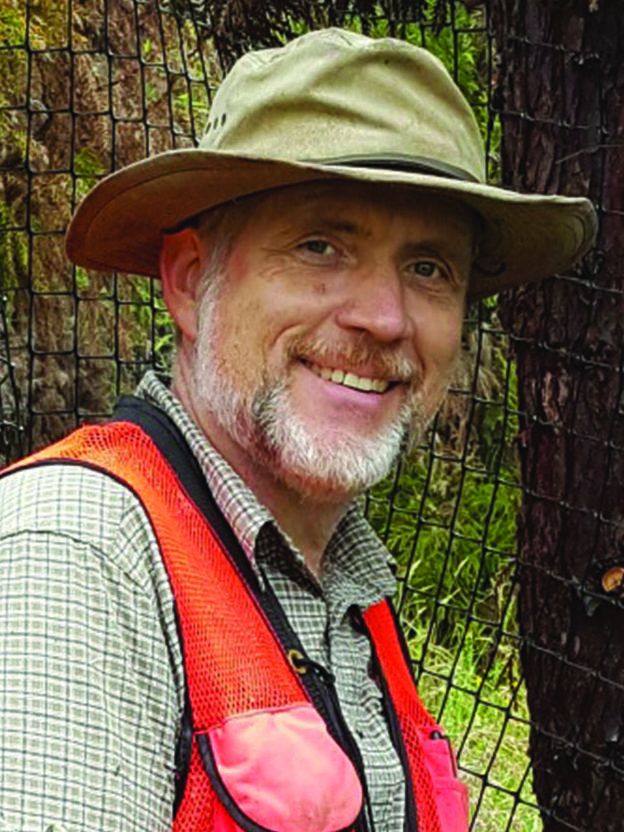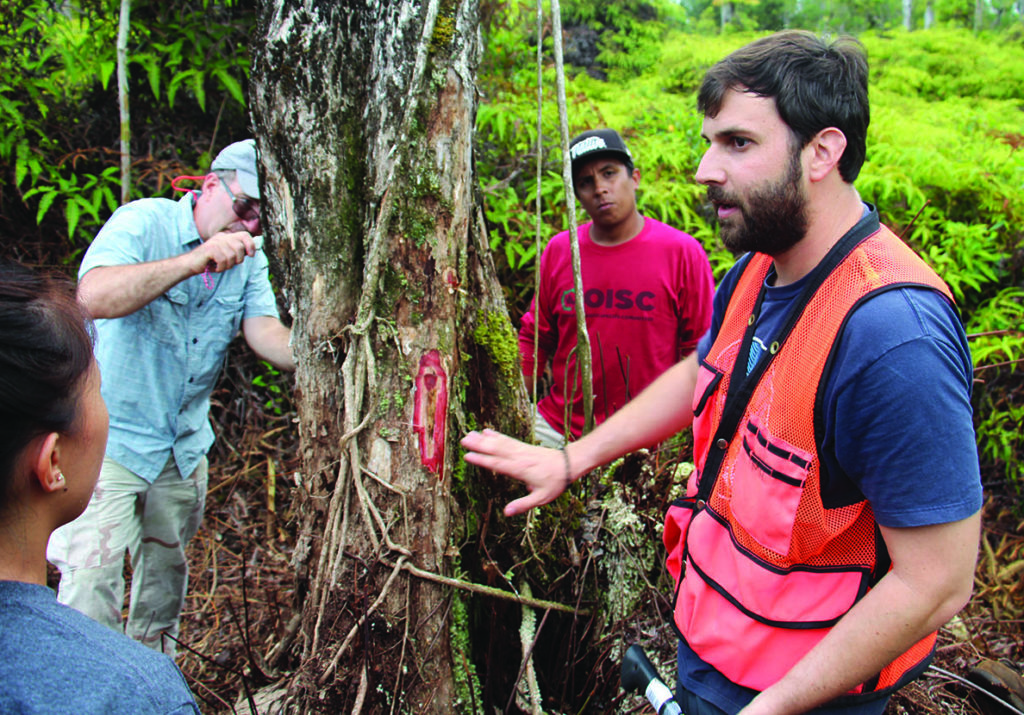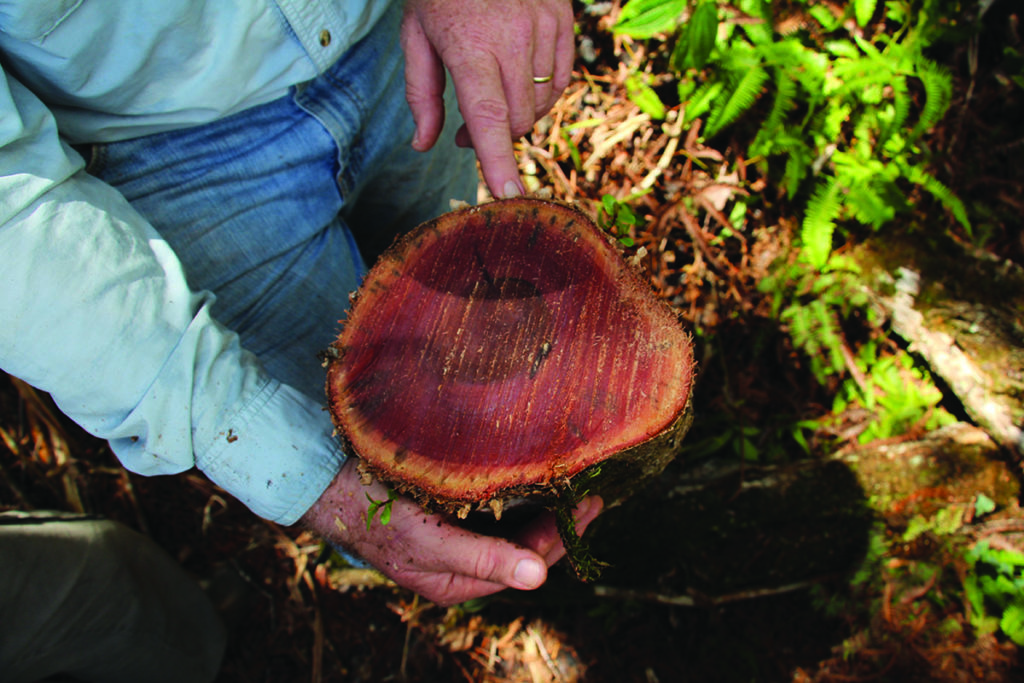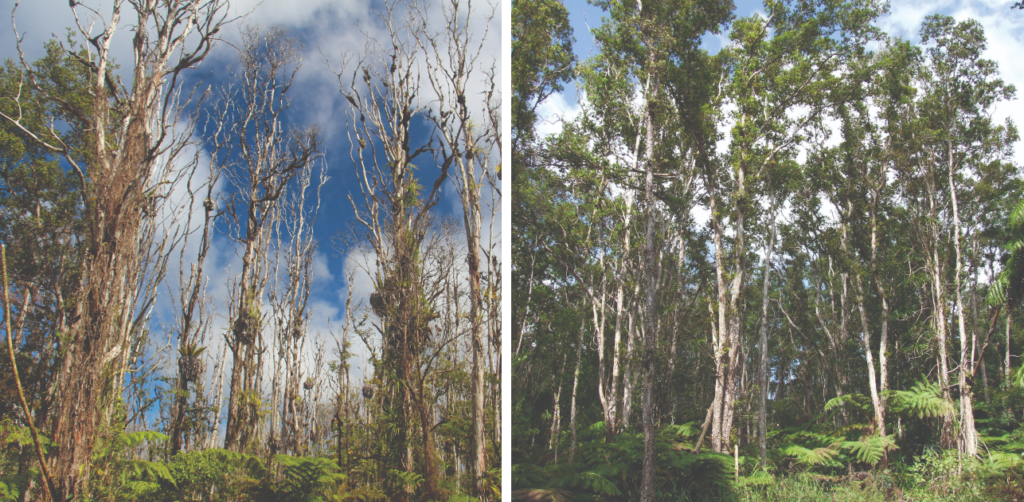UH Researchers Lead the Fight on Rapid ‘Ōhi‘a Death
The ‘ōhi‘a tree, easily recognized by its bright red and yellow flowers, is deeply woven into the Hawaiian culture. Although, ‘ōhi‘a serves as a multitude of symbols and physical manifestations of deities, it is perhaps best known as a symbol of the volcano and in traditional Hawaiian religion is sacred to Pele, the goddess of volcanoes and fire—and creator of the Hawaiian Islands.
Today, ‘ōhi‘a is also highly valued in commerce as it is used for flooring, house posts, fencing posts, decoration, framing and firewood. ‘Ōhi‘a seedlings are also among the most sought-after plants for native landscaping, as well as restoring native forests.

However, a new fungal disease called Rapid ‘Ōhi‘a Death (ROD) has been devastating ‘ōhi‘a forests on Hawai‘i Island and was recently discovered on Kaua‘i. In response, researchers throughout the University of Hawai‘i System (UH System), along with collaborators at the USDA Agricultural Research Service, USDA Forest Service, Iowa State, Stanford University and other institutions are on discovering ways to manage the disease and reduce its spread.
On point for the UH System is J. B. Friday, the extension forester at University of Hawai‘i at Mānoa’s College of Tropical Agriculture and Human Resources (CTAHR) Cooperative Extension Service. Friday, who is based at CTAHR’s Komohana Research and Extension Center in Hilo on Hawai‘i Island, has been working tirelessly to raise both the public’s awareness of ROD and the necessary research funding to combat the disease—since it was first identified in 2014.
“The most prominent endemic tree in Hawai‘i is the ‘ōhi‘a—covering close to one million acres of land, primarily in the upland areas of the islands,” said Friday. “The ‘ōhi‘a tree protects the island watersheds and shelter rare native bird and plant species. It is often among the first plants to colonize fresh lava substrate, making ‘ōhi‘a instrumental in the process of soil development and ecological succession.”
Detection and Understanding
Wade Heller, a molecular biologist in CTAHR’s Department of Natural Resources and Environmental Management, is currently working with Lisa Keith, a research plant pathologist at the USDA Daniel K. Inouye U.S. Pacific Basin Agricultural Research Center in Hilo, on tree pathogens. When the pathogenic fungus Ceratocystis was first diagnosed on ‘ōhi‘a, Heller and Keith realized that this was a new and potentially very destructive disease, based on outbreaks of Ceratocystis on other trees in other parts of the world. The pair developed DNA markers for the fungus and compared them with the global database of known Ceratocystis species, of which there are dozens. To their surprise, they found not just one but two new pathogens infecting the ‘ōhi‘a, neither of which had been previously detected anywhere else in the world. The team is now working on more sensitive diagnostic tests for the fungus which can pick up traces of even a single spore. More precise detection methods will help mangers trace the mechanisms by which the fungus moves and help in management of the spread.
A Look at the Whole Tree

Marc Hughes of CTAHR’s Department of Natural Resources and Environmental Management is furthering the understanding of how the pathogen kills trees and what ways wood can be treated to avoid spreading the disease. Working with Keith and Jennifer Juzwik of the USDA Forest Service, who has worked on Ceratocystis diseases of oak and hickory on the mainland for years, Hughes has described two different diseases caused by the two species of fungi. Ceratocystis lukuohia causes a vascular wilt where the fungus rapidly moves through the xylem and kills the tree rapidly. Ceratocystis huliohia causes a localized canker and, while it can also kill ‘ōhi‘a trees, is much less virulent.
Last year, these fungi were given Hawaiian names in recognition that they were discovered in Hawai‘i, although they were undoubtedly accidentally introduced to the state recently. The more virulent pathogen is named Ceratocystis lukuohia, which means “destroyer of ‘ōhi‘a” in Hawaiian, while the second pathogen is C. huliohia, which means “overturns ‘ōhi‘a.” Ceratocystis lukuohia is related to the Latin American clade of Ceratocystis while C. huliohia is related to Asian species, suggesting that there have been multiple introductions to Hawai‘i.
Hughes and Juzwik are also working on ways to treat ‘ōhi‘a wood so that it can be shipped off-island. Currently the Hawai‘i Department of Agriculture imposes a quarantine on ‘ōhi‘a products on Hawai‘i Island, but demand exists for ‘ōhi‘a products, particularly wood posts for architectural uses, across the state. Individual posts are tested for presence of the fungi before they may be shipped, but a treatment would be far superior in ensuring that an infected log is not accidentally included in a shipment. Hughes and his colleagues found that small-diameter posts could be treated by heating in conventional wood-drying kilns, however kiln drying would be impractical for larger posts that would be used as columns along an entryway or for a lanai. As an alternative, they are testing a process where the wood posts are heated by steam injection into a vacuum kiln. Because of the vacuum, the superheated steam rapidly penetrates the logs. Initial results show that logs heated overnight in the kiln reach temperatures that should kill any fungus. Should the test be successful, the Hawai‘i Department of Agriculture could adopt a standardized protocol for treating ‘ōhi‘a logs that would allow wood from Hawai‘i Island to be safely used in buildings across the state.
A Look at the Entire Forest

Associate Professor Ryan Perroy at the University of Hawai‘i at Hilo’s (UH Hilo) Department of Geography and Environmental Science uses helicopters and small unmanned aerial systems (sUAS), or drones, to conduct frequent surveys of areas affected by ROD to understand how the disease progresses through the forest. Through images taken by high resolution sensors, individual trees can be seen and their health status tracked over time.
Perroy’s results have shown that new outbreaks often begin with just a few trees displaying characteristic symptoms, a reddish browning of the leaves. The number of symptomatic trees then rapidly accelerates, with many new cases appearing in subsequent months, and then eventually leveling off, in most cases before reaching 100 percent mortality. These patterns of mortality may provide evidence for the current theory that new outbreaks can begin with a single event such as a windstorm that breaks branches and injures trees, allowing the fungus to get a foothold. Injured trees tend to die off together, leaving some survivors. Trees that continue to appear healthy following an initial disease outbreak may have escaped infection, may be infected but have yet to express symptoms, or they may be actually resistant to the fungus. Wounding by ungulates also plays a role, as mortality levels are often starkly different across fence lines separating unmanaged areas from ungulate-free zones.
Perroy, Hughes and Keith are collaborating together on laboratory and field experiments to collect and analyze repeated spectral data of inoculated seedlings and trees to determine if ROD infected ‘ōhi‘a trees can be identified before showing visual symptoms of the disease. If forests could be monitored for these signs of stress by the use of hyperspectral cameras mounted on drones, managers could have an early warning of disease outbreaks.
The Future
Although ROD can be devastating, some ‘ōhi‘a trees survive even in the worst affected forests. To test whether these are actually resistant to the disease, graduate student Blaine Luiz in the Tropical Conservation Biology and Environmental Science (TCBES) program at UH Hilo inoculated seedlings of four of the ‘ōhi‘a varieties native to Hawai‘i Island with Ceratocystis lukuohia. Working with Keith and Rebecca Ostertag, Elizabeth Stacy and Patrick Hart of the UH Hilo Biology Department, Luiz found that while all seedlings of Metrosideros polymorpha var. polymorpha and most of var. glaberrima died, some individuals of var. incana and var. newellii survived. While he was only able to test a few dozen seedlings of each variety, the results clearly show that some genetic resistance to the pathogen may exist in ‘ōhi‘a. Resistant individual trees could be used to breed resistant lines of ‘ōhi‘a to enable reforestation of some of the harder hit ‘ōhi‘a forests. “Management of Rapid ‘Ōhi‘a Death in Hawai‘i will be a long-term problem,” noted Friday. “However, in a few short years, scientists at UH and our colleagues around the world have learned enough about the disease that forest managers have hopes of being able to control the spread of the disease and mitigate its effects. Foresters have every hope that ‘ōhi‘a forests will still cover the mountains of Hawai‘i for a long time to come.”

